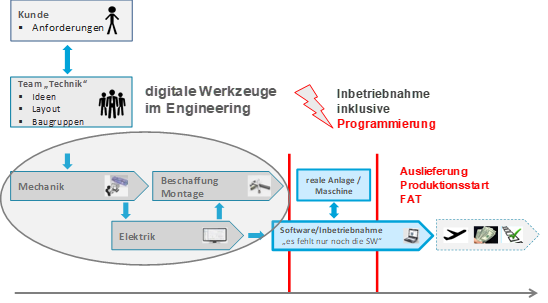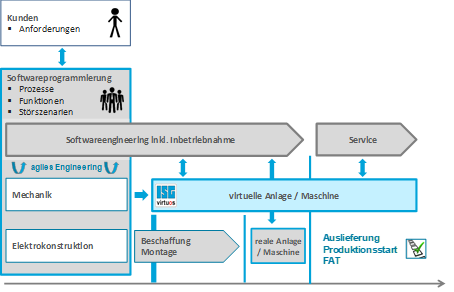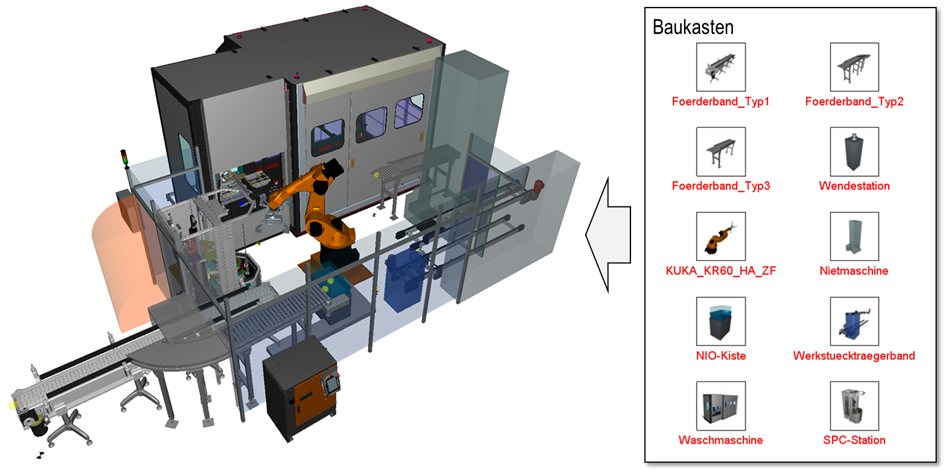In classic mechanical and plant engineering, commissioning is one of the critical process steps. After all, possible weaknesses in the control software can only be identified at this late stage. These can lead to costly reprogramming or even mechanical modification of the plant. By testing the commissioning in advance on a digital twin and optimizing it first in the digital world, unpleasant surprises of this kind are now a thing of the past. What's more, if the digital twin of the virtual plant is made up of individual assemblies, the designer can try out different variants at low cost and thus adapt the plant to the customer's specific individual requirements. If, in addition, existing digital twins of the assemblies used in the plant are used on an open platform in the form of a modular system, the effort required is reduced even further. Since the control system can be created on the virtual plant in parallel with the construction of the real plant, there are also no waiting times with regard to plant availability. The entire development process can thus be shortened even further compared with the conventional approach, despite the customizing of the plant.
The challenges of customizing
Customers are increasingly demanding machines and systems tailored to their needs. This means that every machine or system is unique. In this context, software development is increasingly becoming an integral part of the commissioning phase, since the increasing complexity of the systems can only be mastered by programming the functionalities on the real system. In manufacturing, about two thirds of the control software (PLC program) is used for error detection and primary error reaction. Up to now, it has only been possible to test this part when the plant is put into operation, because only here can the specific error patterns be provoked. To make matters worse, certain fault situations cannot be produced in reality, for example because of the associated risks to people and the environment or in order not to damage or even destroy the plant.
Developing software simultaneously with mechanics and electrics
This challenge is optimally solved with virtual commissioning. In this way, the plant is available digitally at an early stage of the engineering process. Software development can start during the construction phase at the latest, ideally already during the planning of the plant. This means that, compared to the classic approach, the software is usually available at an earlier stage. This shortens the development time and allows optimizations (processes, mechanics, sensor positions, etc.) to be made in the plant design - an aspect that is a huge advantage, especially in view of the often tight schedules and project delays.
Increasing the quality of the plant and the control system
System tests can be performed with real fieldbuses and in control real time. Since it is possible in virtual space to continually adjust and test the control software, as well as the plant, and then "turn a cog" again, you get improved software quality but also increased plant performance. For example, a sensor can be relocated or a missing one added within seconds. And because every malfunction or error scenario can be virtually simulated in a reproducible, cycle-accurate manner, plant reliability and thus quality are also increased.
Training personnel on real scenarios
Critical situations can be simulated on the computer that are better not caused in reality, even for training purposes, or cannot be caused at all because the plant has to produce. With training in the virtual world, however, operators can be well prepared to react correctly in the event of an incident and restart production as quickly as possible. The training on the computer also increases the productivity of the plant - after all, the plant operators can start immediately after commissioning the machine without first having to complete an "operator crash course" and blocking the plant in the process.
Modular design reduces costs
There are even more advantages to be gained by building the plant on a modular basis. Experience shows that even in special plant engineering, 80-90 percent of a plant is built from standard assemblies. During commissioning of the plant, the main thing here is to test the ever new combination of assemblies tailored to the customer. In addition, there is customer-specific technology in the sense of new developments.
These assemblies include, e.g., kinematic units, tool and workpiece handling, and the tools themselves with their respective specific features. If several designers, even from different disciplines, are entrusted with the development, then they can work on the various assemblies in parallel. As soon as all assemblies have been completely described, i.e. mechanically, electrically and in terms of software, the entire system can be configured. The resulting modular design of the system from separately tested and approved assemblies also helps to optimize procurement.
The process is even faster if the virtual assemblies already exist. The virtual plant is then configured from parameterizable assemblies. This process can even be completely automated by a configuration specification (bill of materials). The platforms required for this purpose for the provision of digital twins, which are shared by machine and plant manufacturers as well as component and assembly suppliers, already exist at ISG: The TwinStore contains libraries of various virtual assemblies, for example for robot systems, drive technology, conveyor technology, gripping systems and sensor technology. These will be successively expanded.
Configuring across departments and generating virtual systems instead of modeling them
Many individual assemblies can be used for different projects, but only need to be designed once. In reality, however, one builds up a total of three digital construction kits in this way: the mechanical, the electrical and the control components. In the future, however, it will be important for these three construction kits to merge into one mechatronic construction kit and for the assemblies within it to be described with the same mechatronic system boundaries in each of the three disciplines. Added to this is the virtual assembly, which expands the mechatronic construction kit - the digital twin becomes part of the construction kit. Designers, electrical engineers and software developers, supported by project planning tools, use this construction kit for each new project. The digital twin can then be generated on the basis of a plant's bill of materials - the virtual plant is thus created by naming and automatically parameterizing the assemblies used and not by manual modeling.
Real Time Savings Proven
ISG has developed model generation based on mechatronic assemblies in customer projects. One of them is a reference plant of medium size for furniture production with 246 assemblies, 3242 I/O via several fieldbus systems and two control systems. The time required to create the model has shrunk from 90 man-days to 15 minutes thanks to the approach described above.
What has to be considered during modularization?
The entire plant is divided into mechatronic assemblies that are self-contained. The various mechatronic assemblies form hierarchically superordinate functional assemblies until the overall system is finally created. The goal must be to create reusable units in the modular system that can be used again immediately and without effort. Sensible model generation is best accomplished using the assembly list, which is also used for procurement, assembly and software programming. The adaptation of reusable assemblies should then mainly be done by parameterization.
Advantages of modular project planning for machines and plants
- Designers rely on tested assemblies that are used several times in different plants. This reduces development costs and development time and increases quality.
- If plants are modular, the virtual machine can also be assembled in a modular way. In this way, it is possible to quickly and flexibly try out different combinations of assemblies virtually and thus quickly arrive at a customer-specific solution that is ideally tailored to the application.
- Virtual machines and plants can be created automatically from a construction kit. The necessary sets of rules can already be integrated into the currently available construction kits of well-known project planning tools. This reduces the required modeling time to a minimum and the virtual plant is immediately available.
- Already during the creation of the virtual assemblies, all disciplines involved - mechanics, electrical engineering, computer science - inevitably come together and exchange information at an early stage and not only when the plant is mechanically built and electrically wired. In terms of design, layout and optimization of the plant, this is an enormous gain in time and efficiency.
5 tips on what you should bear in mind when modularizing
- Always build the modules mechatronically. This means that each assembly is described via mechanical, electrical, functional and energy interfaces - there are no others.
- Allow only these defined interfaces for all disciplines involved - mechanics, electrical engineering, computer science - this is the only way to build a kit that is valid across all disciplines. And only in this way can the virtual assembly be added as a fourth discipline.
- Keep it simple. The structure of assemblies must be designed to make them as uncomplicated as possible. Simple assemblies can then be combined into more complex functional assemblies. The goal is to maximize the reusability of both the structural and functional assemblies.
- Limit the variants! Even if it is possible to build an assembly with components from different manufacturers, you should limit yourself to a few variants or create appropriate abstraction layers. This is the only way to increase reusability, the only way to make the assembly easy to maintain, and the only way for designers to maintain an overview.
- Do not use an assembly in a customer project until it is fully described in all four (!) disciplines - mechanical, electrical, IT, digital twin. If one of the disciplines changes the assembly and thus creates a new version of it, the other disciplines are obliged to adapt and release the assembly as well.
Plant only as good as the individual virtual assembly
How well a plant can be virtually engineered and commissioned depends crucially on the quality of the building blocks and their individual assemblies. An absolute must is the training of all employees who will work with the digital twins. ISG consultants also provide support with their experience and expertise when it comes to concepts and guidelines for data procurement or the creation of digital twins. It is worth investing in the topic of virtual modular plant, because it saves time and money.
Author: Dipl.-Ing. Stefan Scheifele, Head of Consulting Process Management Virtual Commissioning at ISG Industrielle Steuerungstechnik GmbH



